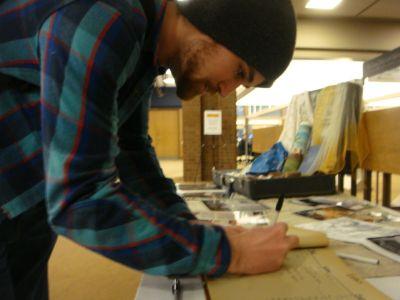When the Willard State Hospital closed in 1995, a number of belongings of patients were left behind. These items, which included suitcases, shoes and journals, highlight the difficult personal stories of patients who spent decades in this hospital, unable to gain their freedom or to live with dignity.
Many of these artifacts are on display as part of an exhibit currently at Odegaard Library, “The Willard Suitcases, The Lives They Left Behind.” The exhibit is part of the winter 2011 series of lectures and films, “Unspeakable: Disability History, Identity and Rights,” which aims to provide forums for conversations about perspectives on past and present disability issues.
“[The exhibit] inspires questions of what kind of laws that we created that allowed for this to happen,” said Martin Ihle, a senior studying LSJ. “Law and policy… are motivated by a general narrative and that narrative doesn’t always take into account certain groups of people—especially underrepresented groups.”
As part of the lecture series, Eli Clare, a well-known transgender disabled writer and activist, visited campus and spoke about the Supreme Court case, Buck v. Bell (1927), which declared involuntary sterilization constitutional. The case was built upon the body of Carrie Buck, a woman who was forced to undergo compulsory sterilization while she was an inmate at Virginia State Colony for Epileptics and Feebleminded.
Many individuals, like Buck, were sent to either state hospitals or residential habilitation centers (RHC) because the state had a duty to care for them. As a result, the state made decisions on most aspects of their life. Because there was no due process afforded to them, residents like Buck were ignored and their basic human rights to bodily integrity and humane treatment commonly denied.
“It is important to define disability as a community that often times endures human rights violations and it is especially important to include disability in law and policy because the issues that are decided by the majority often times have a different and disproportionate impact on people with disabilities,” said Rosanna Sze, director of the ASUW Student Disability Commission.
Joanne Woaik, a lecturer in the Disability Studies program who also teaches LSJ 332, “Disability and Society,” explained that people with psychological impairments were institutionalized with the rationale that they would be cured and taught skills, and because of the belief that they needed to be removed from society to protect others.
Ihle, a current student in LSJ 332, said that the exhibit is a way to consider the real world implications of what he is studying and how disability rights play into the human rights movement.
“These people were institutionalized because they were fundamentally misunderstood and committed by close family members…because they didn’t have an option to leave, their possessions were taken from them and they didn’t get these possessions back,” said Ihle.
During his talk, Clare discussed the engineers of the Buck v. Bell court case and how they used Carrie’s body as legal precedent. Clare explained that so many records have been mislaid, forged and burned and if it hadn’t been for that court case, Carrie would have never been a placeholder in history. Instead, she would have been a number, a lost detail, and another poor woman caught in the grind.
As if the stigma of disability were not enough, eugenicists argued that it was in the state’s best interest to have Buck sterilized based on the scientific ideas that behaviors were linked to genetics.
“The law reflects societal values and, occasionally, it can help change those values,” said Sherrie Brown, director of the Disability Studies Program. “My hope is that more individuals will begin to recognize that we have denied equal citizenship and humanity to many people based on their perceived value and capacity based on the label of disability.”
Although institutionalizations like those that occurred at the Willard State Hospital may seem like a matter of the past in the United States, it is important to note that historically, institutions have been a popular way to treat mental health patients.
“The exhibit is a call for human rights because it leads us to reflect on the mental health industry, it brings up a lot of ethical issues regarding the past of psychiatry, which helps us to prevent future human rights abuses in that field,” Sze said. “Just by going through the exhibit, people are left wanting more.”
For more information about the “Unspeakable” lectures and films, please go to http://uwdisability.wordpress.com or contact Joanne Woiak, UW Disability Studies Program, jwoiak@uw.edu.
This article was composed by Charlotte Anthony.
